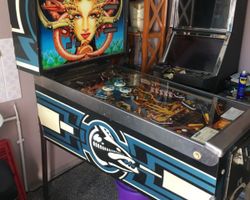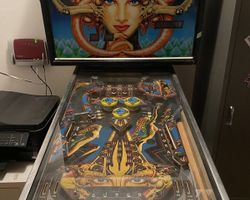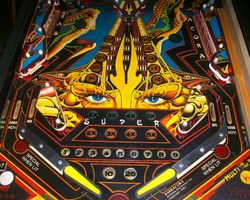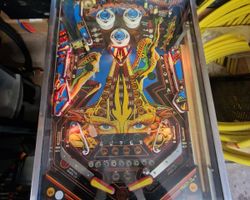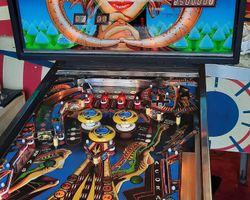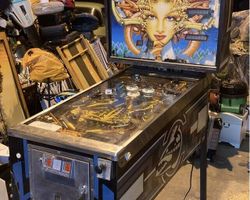Barracora
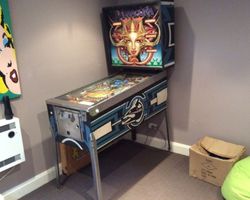
Average Prices: USD $200 to $1,700
Produced: September, 1981
Production Run: 2,350 units
Machine Type: Solid State Electronic
MPU: Williams System 7
Players: 4
Design by: Barry Oursler, Roger Sharpe, Steve Epstein
Art by: Doug Watson
Sound by: Ed Suchocki
Software by: Ed Suchocki
Barracora, a solid-state pinball machine introduced by Williams Electronic Games, Inc. in September 1981, marked a distinct entry in the era of Williams System 7 machines. With 2,350 units produced, this machine carved out its own space with a unique thematic blend of fantasy, science fiction, and a stylized aquatic motif. The concept for Barracora originated from a collaborative effort, with pinball designers Roger Sharpe and Steve Epstein laying the foundational design. Barry Oursler then translated their vision into the physical realm, building the whitewood based on Sharpe's mylar layout. This shared genesis resulted in a machine that offered more than a simple linear play experience.
The visual identity of Barracora is a cornerstone of its appeal, largely due to the distinctive artwork of Doug Watson. Watson drew inspiration from the surreal and often unsettling style of Swiss artist H.R. Giger, particularly for the striking backglass and playfield imagery. His vision manifested as a predatory fish morphing into a model's head, set against a "landscape of teeth," creating an aesthetic that was both captivating and unconventional. The machine's name itself has an interesting backstory; originally conceived with names like ‘Las Vegas’ and ‘Jet Orbit’, it was Watson’s artistic rendition, initially titled 'Barracuda', that prompted Williams president Mike Stroll to suggest a name change due to perceived negative connotations. Watson's swift suggestion of 'Barracora' for the enigmatic woman in his art resonated, becoming the machine's final designation. Subtleties in Watson’s playfield art, depicting discrete artistic forms, further underscore the depth of his contribution. The sound design, crafted by Ed Suchocki, complements the visual experience with electronic audio cues that resonate with the arcade games of the period, contributing to the overall immersive atmosphere.
Signature Features and Design
Barracora distinguishes itself with a combination of engaging mechanical features and an artistic presentation that defines its character. The central attraction is undoubtedly the striking artwork by Doug Watson, particularly the backglass, which serves as an immediate visual hook. This Giger-inspired imagery, depicting the transformative "Barracora" figure, is both detailed and evocative, setting a surreal tone for the entire game. The playfield artwork extends this theme, integrating the aquatic and fantastical elements seamlessly into the game's layout, complete with the "landscape of teeth" aesthetic.
Beyond the visuals, Barracora introduced mechanical elements that were sophisticated for its release year. It features both 2-ball and 3-ball multiball modes, a significant draw for players seeking dynamic gameplay. A key interactive element is the pair of drop target banks: a 5-bank on the left and a 3-bank on the right, which require precise, sequential hits for progression. This sequential requirement adds a layer of strategy. Another notable innovation is the "double lane change" feature located at the top of the playfield, providing players with more control over ball routing and a distinct strategic choice. Furthermore, the upper lock mechanism serves a dual purpose, functioning both as a ball lock for multiball initiation and a unique save feature that can kick out a drained ball, offering a reprieve during intense play. The spinning target adds a tactile and auditory reward, while the horseshoe lane presents a challenging shot that rewards accuracy.
Playfield and Mechanics
The Barracora playfield offers a clean, open layout that encourages fluid ball movement and shot accuracy. Two flippers control the action at the bottom of the playfield, guiding the ball towards a variety of objectives. Three pop bumpers, strategically placed, contribute to lively ball rebound and random action, while two slingshots further define the lower playfield's chaotic energy.
Major shots include the horseshoe lane, which curves around the upper portion of the playfield, and a prominent spinning target that rewards direct hits. The two kick-out holes provide distinct objectives, one serving as the crucial upper lock for multiball. The playfield is dominated by two sets of drop targets: a five-bank on the left side and a three-bank on the right. These are central to the game's progression, requiring players to hit them in a specific order to activate features and advance scoring. Additionally, three standup targets are positioned in the center, typically used for bonus multipliers. A rollunder lane is also present, providing additional scoring opportunities.
Doug Watson's artwork extends across the entire playfield, integrating the surreal "fish-woman" theme with the mechanical elements. The "landscape of teeth" motif frames the playfield, creating an enveloping visual experience. Lighting is used effectively to highlight active targets and modes, drawing the player's eye to current objectives and emphasizing the game's progression. The layout's design philosophy prioritizes shot precision and strategic planning over pure speed, immersing the player in a game that demands thought and accuracy.
Gameplay Dynamics
Barracora’s gameplay dynamics reward precision and strategic play, offering a surprising depth for a machine of its era. The scoring system is intricately tied to the sequential completion of drop target banks. Players must hit the targets in a specific order, which not only awards points but also advances game objectives and bonus multipliers. Building bonus multipliers is a core strategy, often achieved by hitting the central standup targets. This bonus structure encourages players to develop a comprehensive approach to the playfield, rather than focusing on a single high-scoring shot.
Multiball is a significant feature, with both 2-ball and 3-ball modes available. Activating multiball typically involves locking balls in the upper kick-out hole. A distinct gameplay highlight occurs when the highest score in a multiplayer game activates a 30-second, 3-ball multiball, offering an intense, time-limited scoring opportunity that persists until the timer expires. The double lane change feature at the top of the playfield introduces an interesting strategic layer, allowing players to direct the ball into advantageous lanes for bonus accumulation or target access.
One of Barracora's distinguishing features is its unique ball-save mechanic integrated with the upper lock. If a ball drains after being locked in this saucer, the game can kick it back into play, providing a valuable second chance and adding a layer of player-friendly design. The game's progression centers on achieving these various objectives—completing drop target sequences, building bonus, and initiating multiball—which combine to create a compelling and challenging experience.
Reception and Legacy
Barracora is generally regarded with high esteem within the pinball community, particularly as a standout machine from the early 1980s. Its primary strength consistently cited is its unique and compelling artwork. Doug Watson’s Giger-inspired backglass and playfield art are frequently praised as captivating and ahead of their time, drawing players in with its surreal "fish-woman" aesthetic. This visual distinction sets it apart from many contemporaries.
Beyond the visuals, Barracora receives significant acclaim for its ruleset and gameplay depth. For an early solid-state machine, players appreciate the strategic layers, such as the sequential drop target objectives and the importance of building bonus multipliers. The inclusion of two-ball and three-ball multiball, coupled with the distinctive upper lock/save mechanism and the double lane change feature, demonstrates thoughtful design that encourages varied shot-making and tactical decisions. Players often describe the game as challenging but fair, fostering a "just one more game" appeal. The sound package, while electronic, evokes the classic arcade experiences of the era, further enhancing its immersive quality. The playfield layout is often described as clean and well-flowing, with satisfying shots.
However, Barracora is not without its criticisms. The most common point of feedback centers on the absence of speech or voice callouts, a feature that many players feel would have significantly elevated the experience, especially given its strong visual presentation. Some modern players, accustomed to the feature-rich machines of later decades, might find the gameplay somewhat dated despite its depth for its time. While the playfield and backglass art are lauded, the cabinet artwork is sometimes considered less impactful by comparison. Additionally, some players find the upper lock shot challenging to hit consistently, and without certain ROM updates, the initial scoring impact of multiball might not be as pronounced as desired. Despite these points, the machine's distinct "fish women" theme, while acknowledged as unusual, is often seen as a compelling and unique aspect rather than a weakness.
Barracora maintains a strong reputation as a "player's game"—a machine that rewards skill, understanding of its rules, and strategic execution. Its influence stems from its innovative rule complexity for the period and its unforgettable artistic presentation. It stands as a testament to Williams' design prowess in the early solid-state era, showcasing how depth could be achieved through clever mechanics and compelling art, even without the advanced features that would become standard in later machines. It continues to be sought after by collectors and played with enthusiasm by pinball aficionados, solidifying its place as a memorable and significant entry in pinball history.
Sponsored Links
 Ebay Listings
Ebay Listings
 Auction Results
Auction Results
| Cost | Location | Date |
|---|---|---|
| GBP £588 |  United Kingdom United Kingdom |
29 December, 2024 |
| USD $3,900 |  Idaho, United States Idaho, United States |
19 August, 2024 |
| GBP £741 |  Clacton-on-sea, United Kingdom Clacton-on-sea, United Kingdom |
04 May, 2024 |
| EUR €2,150 |  Nordrhein-Westfalen, Germany Nordrhein-Westfalen, Germany |
23 April, 2023 |
| EUR €1,750 |  Bayern, Germany Bayern, Germany |
25 March, 2023 |
| USD $5,000 |  Washington, United States Washington, United States |
16 January, 2023 |
| EUR €1,000 |  Schlewig-Holstein, Germany Schlewig-Holstein, Germany |
11 December, 2022 |
| EUR €2,550 |  Nordrhein-Westfalen, Germany Nordrhein-Westfalen, Germany |
13 November, 2022 |
| USD $3,000 |  New York, United States New York, United States |
07 August, 2021 |
| USD $3,000 |  California, United States California, United States |
21 July, 2021 |


Private Policy · Search Website · Contact Us
As an eBay Partner, we may earn a commission from qualifying purchases made through links on this site, at no additional cost to you.
All trademarks and copyrighted materials remain property of their respective owners. All other content copyright 2007 - 2025 Pinpedia.

